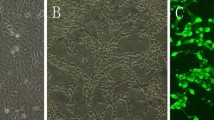Abstract
Canine parvovirus (CPV) is a non-enveloped virus with a single-stranded DNA genome and causes infectious enteritis in dog. In this study, 36 isolates of CPV infection were obtained in Taichung, Taiwan from 2003 to 2004. Using primers that can distinguish subtypes of CPV, we amplified part of viral VP2 gene by polymerase chain reaction (PCR) and the PCR product was sequenced; results demonstrated that two isolates could be classified as type 2a of CPV and the others were type 2b. The complete coding region of VP2 gene of type 2b was also sequenced, and phylogenetic analysis of these DNA sequences revealed that our Taichung isolate was close to the V-120, FPV-314, 97-008, Taiwan 9, LCPV-T1, and T4 isolates; however, because of the degeneracy of codons, the amino acid sequences of Taichung isolate was similar to that of the 97-008 isolate from Japan. It is known that two important amino acid residues (Asn-426 in type 2a and Asp-426 in type 2b; Ile-555 in type 2a and Val-555 in type 2b) are the determinants for the discrimination of type 2a or type 2b. After scrutinizing the complete VP2 gene of our Taichung isolate, we found the VP2 protein of the Taichung isolate did possess this molecular feature of type 2b virus. Previous studies reported that type 2a virus was the major type in Taiwan; our finding showed that CPV type 2b was the predominant type in the middle part of Taiwan. Moreover, a unique Ala-489 in VP2 of our Taichung isolate was found, contrasting to a Val-489 in the VP2 of other strains.
Similar content being viewed by others
References
K. Hueffer C.R. Parrish (2003) Curr Opin Microbiol 6 392–398
C.R. Parrish (1999) Vet Microbiol 69 IssueID1–2 29–40
C. Buonavoglia V. Martella A. Pratelli M. Tempesta A. Cavalli D. Buonavoglia G. Bozzo G. Elia N. Decaro L. Carmichael (2001) J Gen Virol 82 IssueIDPt 12 3021–3025
C.R. Parrish C.F. Aquadro M.L. Strassheim J.F. Evermann J.Y. Sgro H.O. Mohammed (1991) J Virol 65 IssueID12 6544–6552
M. Nakamura Y. Tohya T. Miyazawa M. Mochizuki H.T. Phung N.H. Nguyen L.M. Huynh L.T. Nguyen P.N. Nguyen P.V. Nguyen N.P. Nguyen H. Akashi (2004) Arch Virol 149 IssueID11 2261–2269
C.A.D. Pereira T.A. Monezi D.U. Mehnert M. D’Angelo E.L. Durigon (2000) Vet Microbiol 75 IssueID2 127–133
M. Senda C.R. Parrish R. Harasawa K. Gamoh M. Muramatsu N. Hirayama O. Itoh (1995) J Clin Microbiol 33 IssueID1 110–113
Y. Ikeda M. Mochizuki R. Naito K. Nakamura T. Miyazawa T. Mikami E. Takahashi (2000) Virology 278 13–19
W.L. Chang A.C. Chang M.J. Pan (1996) Vet Rec 138 IssueID18 447
Truyen (1999) Vet Microbiol 69 IssueID1–2 47–50
Author information
Authors and Affiliations
Corresponding author
Rights and permissions
About this article
Cite this article
Wang, HC., Chen, WD., Lin, SL. et al. Phylogenetic Analysis of Canine Parvovirus VP2 Gene in Taiwan. Virus Genes 31, 171–174 (2005). https://doi.org/10.1007/s11262-005-1791-0
Received:
Accepted:
Issue Date:
DOI: https://doi.org/10.1007/s11262-005-1791-0




